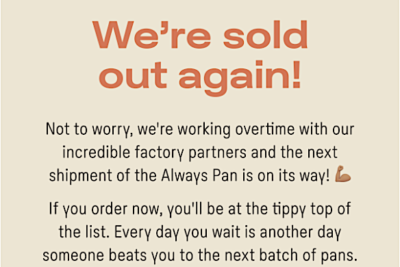Brands and companies that have halted their email campaigns should be mindful of their IP reputation. There isn’t a hard-and-fast ruleset, but programs resuming after inactivity lasting more than 2 to 3 weeks (~30 days) should follow IP warming best practices.
Expert guidance warns against halting campaigns, if possible. Brands should aim to find ways to continue sending, even with slower cadence or lower send volume.
70%+ of us are canceling existing campaigns
Last week, we gathered input from 145 B2C and B2B email marketers. The results revealed that more than 70% are canceling campaigns due to the coronavirus crisis.

These results are expected. We’d even argue it’s the right thing to do.
For example, one of our first actions here at MailCharts was to unschedule our upcoming newsletter campaigns—we didn’t want to be sending out fun, irreverent email ideas when the world is simply in no mood to laugh.
Expert opinion: Do we need to worry about IP reputation?
When considering all the campaigns paused, one of our webinar attendees asked an important question “Do we need to worry about deliverability when we ‘unpause’ our email campaigns and begin sending again?”
The short answer is yes. But we’ve reached out to some experts in the deliverability space for concrete guidance. Here’s what they have to say:
“If a sender does find themselves in a situation where they haven’t sent email for a few months, they should gradually ease back into sending more email … [we recommend following standard warming best-practices] whenever email sending is resumed after a period of inactivity greater than 30 days.”
— Mike Auldredge, Email Delivery Specialist, Customer.io
“When brands resume activity they are going to need to treat it like a brand new start, and deploy a warm-up plan. We’re [recommending to keep some] activity ticking over, even if it’s non-promotional.”
— Guy Hanson, Vice President of Customer Engagement, Validity
“You don’t need to keep up your normal mailing schedule to keep your list fresh. Mailing every couple weeks is more than enough—[keep in mind that] stopping all email is going to cause lists to degrade. Use this time to connect your brand in some meaningful way with your recipients. This pandemic is scary and things are in flux—slow down your cadence, create meaningful content and don’t forget to wash your hands.”
— Laura Atkins, Founding Partner, Word to the Wise
“When pausing mail for any period of time, a warm-up schedule should be followed. Additionally, it’s advisable to send less frequently during this time period, rather than completely stopping. Maintaining even a reduced schedule and volume of mail will allow for your reputation to be maintained, and make growth back to normal volumes easier when the time feels right.”
— Matthew Vernhout, Director of Privacy and Industry Relations, Validity
Examples of campaigns to send
Okay … so if all of us are canceling campaigns, yet the experts suggest we continue sending—what should we do?
Messaging tweaks
Obviously, a straightforward way to keep campaigns humming along in order to ensure IP reputation remains intact is to continue sending! That said, rather than pushing a hard sale with discounts, promotions or deals, brands should be sensitive to the current global mood.
Looking for inspiration? We’ve shared a few examples that hit the right tone. Or, head on over to ReallyGoodEmails to see their growing collection of emails addressing COVID-19.
Finally, we had a few anonymous suggestions from our email marketing community for altering your overall email strategy. Check them out:
“We’ve paused promotional emails and we’re using email to engage with our audience via Q&A, feedback, etc.”
“Our social channel has skyrocketed … email is aiming to push towards social and our blog to involve our audience.”
Adjust send frequency
It’s too early to tell how brands are adjusting their send frequency and send times, but there’s a gray area to consider between sending “normally” and “canceling entirely.”
Consider removing a few campaigns and keeping a few scheduled, splitting up lists across sends and more. This way you’ll be able to continue maintaining your IP reputation but perhaps at a slightly decreased volume.
One email marketer posed this rhetorical question in our survey:
“Do peak send times/best practices even matter any more now that most of our audience is WFH and locked down? I’m going to try to send on a Friday evening to see what happens.”
Embrace testing, segmentation and behavioral targeting
We can continue to lean into what’s been our mantra for years: testing, segmentation and triggered campaigns. In virtually all cases, this will continue to be our best shot to maintain our positive IP reputations.
Interestingly—and somewhat expectedly—when we asked our webinar attendees about this, more than 60% of respondents said they weren’t focused yet on segmentation. Why is this expected? Almost half of email marketers confessed they’re under a deluge of campaign updates, scheduling changes, and more. It’s a chaotic time.
Take it slow
The complex nature of email marketing means many things during these drastic, sudden shifts brought on by the coronavirus pandemic. Our advice is to take a moment to pause, reflect and review.
In doing so, you’ll be able to review your previous campaign calendar and make the necessary messaging, cadence and list/segmentation tweaks—and this will help provide some assurance that your sends will maintain your IP reputation. One way to check your IP reputation is to use a tool like SenderScore, which provides a reputation score for a given IP address based on various factors such as spam complaints and delivery failures.
For those of us who cannot or won’t be able to keep up some type of mailing over the coming weeks and months—it’s going to be okay, too. When you’re ready to get back in action, follow IP warming best practices to rebuild your reputation.
Have questions? Further input? Want to say hi? We’re here at [email protected]—send us a note.
Editorial Image by Schmidsi from Pixabay



